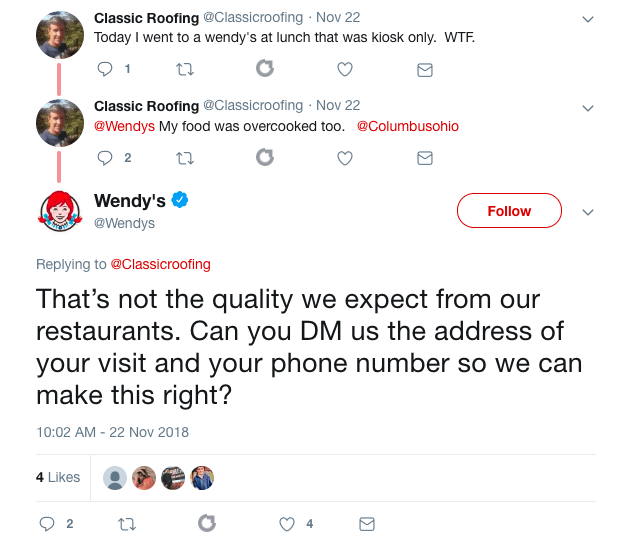When you’re putting together the perfect pitch, Twitter is not a one-size-fits-all channel. In fact, I’d argue that about every social platform. You need a tailored Twitter marketing strategy for each of your clients to find success on the channel.
Each business comes with its own set of needs and preconceived ideas around what to expect from social media marketing. As their potential service provider in that department, it’s on you to prove or debunk their assumptions.
To do so, you have to think strategically relative to the resources at your disposal and the channels you advise on.
With this in mind, what types of brands do well on Twitter?
As online marketing extraordinaire Neil Patel notes, you don’t have to be the most exciting company to be effective with Twitter marketing strategy. The domain registrar Namecheap proves that with their 120,000+ followers.

What you do have to be is engaging and methodical with your approach.
Twitter marketing services
As an agency, here are a handful of Twitter marketing services you can offer to help clients.
Table of Contents
Start your free 14-day Fanbooster trial
Create the perfect Twitter presence for your client's brand
Having a completed Twitter profile is one of the many steps on the way to Twitter success. This will make your client’s account look legit, and ensure that their brand is recognizable by their existing audience on other social networks.
So with that in mind, fill out the following items out on your Twitter profile:
- Profile picture: make sure that this is your client's brand logo, otherwise, your existing audience won't recognize you.
- Bio: add some info about your business here—this can be a synopsis of what your client does or information about a cutting-edge new product that they just released. Some brands prefer to include a hashtag here as well for discoverability.
- Location: add your business location here. It's okay to leave it blank if your client works remotely.
- Web address: link out to your website or another landing page here to get free publicity for your website.
- Cover photo: this graphic lives above your client's bio and profile picture, so get creative and use it to solidify your client's aesthetic.
Make sure that these are filled out and up-to-date before you start posting on Twitter for your client. Not doing this could hurt your client’s brand image, and may confuse their audience into thinking you’re running a spam account.
Manage a Twitter content calendar
Due to the fast-paced nature of a platform like Twitter, many businesses find it intimidating to keep up with. It’s easy to assume you have to quickly pump out a lot of content to stay in the conversation.
While there are instances when timeliness around emerging trends and current events can pay off, you don’t have to be glued to a feed around the clock to find success.
For busy business owners, social media agencies are perfect for managing social content calendars. With advanced posting and scheduling tools at your disposal, it’s easy to organize your efforts cost-efficiently.

When building out your content plan for a client’s Twitter handle, consider their goals.
Are they using Twitter for one or several of the following?
- A customer-facing outlet for support
- Product promotion
- Content distribution
- Lead generation
- Brand awareness
Organize a monthly or bi-monthly editorial calendar of content in advance around a set of agreed-upon categories that make sense for your client (e.g., #MotivationMonday, blog shares, product, curated content, and so on).

Provide support and Twitter marketing strategy for advertising
For clients with a strong Twitter following, consider pitching support for their advertising strategy. This can be extremely valuable by further amplifying their presence.
Twitter even offers a podcast and Agency Playbook geared specifically towards helping agencies succeed on their platform.
Even though Twitter can be a “pay to play” network, its user base can be hyper-aware of promoted content. It’s important to build your Twitter marketing strategy with these nuances in mind.
Lead generation cards, for example, can actually work against the effectiveness of a campaign. The call-to-action buttons are more obvious indicators of advertising, as opposed to promoting content with a link and image, which blends more into the feed.
Handle Twitter community management
A fast-paced feed calls for fast-paced responses. Or, at the very least, responses that are regular and consistent.
Having grown up with these platforms, 44% of Millennials expect a response to their tweeted complaints within an hour.
Without dedicated support, brands can leave their followers and potential customers hanging. It’s not a good look.
On the other hand, brands that respond quickly and empathetically—like Wendy’s—can fuel brand affinity. And bring more followers into the fold.

If a business is going to have a presence on Twitter, they have to play by the expectations of the audiences they want to attract. And community management can make or break a company’s brand image.
Try Twitter chats
Another way to capture attention and build relationships on Twitter? Start a Twitter chat.
Partner with industry experts, create thoughtful questions, and be engaging the day of.
Or, if your client’s audience isn’t quite big enough to support the efforts required to create a successful Twitter chat, become a regular, active attendee of another popular industry Twitter chat.
How to participate in a Twitter chat
- Create a list of Twitter chats with members made up of your relevant target audience.
- Set aside time (usually an hour) to actively participate.
- Introduce yourself and tell people what you have to offer.
- Make sure that all posts include the Twitter chat’s hashtag so people can follow along.
- Answer the questions thoughtfully and use visuals to illustrate your point whenever possible.
- Engage with others on the chat.
Here are some ideas for Twitter chats to join:
- Social Media Examiner’s #SMEChat
- #SEMrushChat
- Madalyn Sklar’s #TwitterSmarter
Find other industry options on TweetReports’ Twitter chat schedule.
Drive proactive Twitter outreach and engagement
People underestimate how important proactive outreach and engagement are on a platform like Twitter. It’s not enough to constantly promote your presence via Tweet and walk away.
Scheduled organic content, timely opportunities, paid Twitter marketing strategy, and engagement all work together to create a holistic and effective Twitter program.
As a social media agency, social media listening tools are your friend. With keyword tracking and complex monitors, you can provide value to clients by identifying potential influencers and engaging with them.
Building this service into your plan ensures you’re also able to narrow in on related, emerging trends. This helps your clients be more opportunistic with their marketing campaigns and improves their potential to connect with customers in the moments that matter most.
Subscribe To Our Newsletter
Get updates and learn from the best
Deep dive into the Twitter analytics
For a client barely keeping up with tweeting once a day, it’s unlikely they dedicate any time towards evaluating performance. As such, reporting is a must to show the success of your twitter marketing strategy.
Client education is crucial for retention and your agency’s long-term success. You have to prove your value over time and the numbers don’t lie.
Make it a point to review comprehensive reporting on a monthly or quarterly basis, depending on your client’s goals. Doing so will keep you in-the-know regarding the latest Twitter trends, allowing you to change course or amp up efforts as needed.

When you can point to tangible improvements in the numbers over time, it will be much easier to sell your clients on expanded services.
Final Thoughts: Ensuring that your Twitter marketing strategy delivers results for clients
Not every brand can afford the number of hours and effort it’d take to optimize every Twitter service mentioned above. When creating a proposal, keep their goals in mind and offer multiple packages that encompass various Twitter marketing strategies, broken down by tiers.
For example, if a client already has a support team, suggest plans that don’t include community management. Instead, offer a one-time training for how to respond on Twitter.
Cater your Twitter program accordingly, knowing efforts can expand down the road as the return on investment is solidified.



